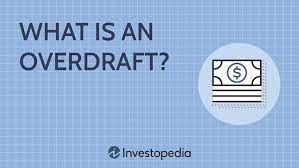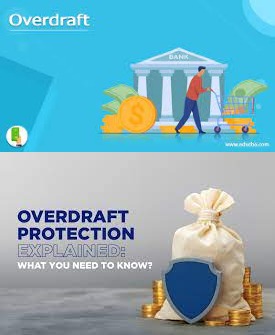Overdraft Explained Fees, Protection, Key Terms, Resources, and Types

What Is an Overdraft?
When a transaction or withdrawal is authorized by the bank even if there isn’t enough money in the account to support it, this is known as an overdraft. In essence, it’s a credit extension given by the financial institution upon the closing of an account. Even when there are no funds in the account or not enough to meet the withdrawal amount, the overdraft enables the account user to keep making withdrawals.
An overdraft is essentially a loan that the bank permits its clients to take out up to a certain amount of money. The loan has interest attached to it, and each overdraft incurs fees. An overdraft fee at many institutions might exceed $35.
Key Takeaways
When a withdrawal from an account is made without sufficient cash, an overdraft happens because the bank permits the transaction to be made.
Even in situations where there is not enough money, the consumer can still pay their bills thanks to the overdraft.
Overdrawn accounts are subject to additional fees or penalties from many institutions.
Like any other loan, an overdraft carries interest and usually carries a one-time insufficient funds fee for the account holder.
When a customer’s account balance hits zero, some banks offer overdraft protection, which prevents insufficient funds fees but frequently carries additional costs like interest.
Understanding Overdrafts
A bank will cover a customer’s overdraft account payments that would otherwise be declined or, in the case of physical checks, bounce and be returned unpaid.
The borrower must pay interest on the remaining amount of an overdraft loan, just like with any other loan. In an emergency, an overdraft is usually a preferable short-term choice because loan interest rates are frequently cheaper than credit card interest rates. The amount available to cover your checks is frequently decreased by additional expenses associated with employing overdraft protection, such as insufficient funds fees for each check or withdrawal.
Banks are permitted to levy overdraft costs; however, they are not permitted to rearrange a customer’s transactions in order to charge additional overdraft fees. For the exploitative practice of arranging customer withdrawals to maximize overdraft costs, Wells Fargo was fined $203 million in 2010.
Special Considerations
To pay for your overdraft, your bank may choose to utilize its own cash. Connecting the overdraft to a credit card is an additional choice. Usually, an overdraft that is financed by the bank itself won’t have an impact on your credit score. You run the risk of accruing more debt when using a credit card for overdraft protection, which could lower your credit score. It won’t, however, seem as an issue with overdrafts on your checking accounts.
Your bank may assign your account to a collection agency if you fail to repay your overdrafts within the stipulated time frame. Your credit score may be impacted by this collection activity, which will also be reported to Equifax, Experian, and TransUnion, the three major credit bureaus. Whether or not it appears as an overdraft issue on a checking account relies on how the account is reported to the agencies.
Overdraft Protection
As a service to the consumer, some banks—though not all—will immediately settle overdrafts (while charging fees, of course.) The consumer has an additional tool with overdraft protection to avoid embarrassing shortages that give a bad impression of your ability to pay.
Typically, it functions by tying your checking account to a line of credit, savings account, or other checking account. This source is used to obtain funds in case of a shortage, guaranteeing that you won’t receive a returned check or have a transaction or transfer denied. Additionally, it keeps a non-sufficient funds (NSF) charge from happening.
The overdraft protection amount varies depending on the account and the bank. Frequently, the client must make an explicit request for it. While there are many benefits and drawbacks to overdraft protection, it’s important to remember that banks don’t offer the service voluntarily. For it, they typically demand a fee.
Customers should therefore be careful to only sometimes and in an emergency rely on overdraft protection. The banking institution has the right to remove the overdraft protection from the account if it is utilized excessively.
Types of Overdrafts
Secured and unsecured overdrafts are the two main categories. The loan is usually backed by a mortgaged asset or collateral, which the bank may sell to recoup its losses if the account holder defaults on the balance owed. Conversely, the unsecured variety permits a smaller credit limit because it is not collateralized.
Some of the most typical overdraft options are listed below:
Overdraft Against Salary:
Borrowers may be qualified for up to three times their pay if they maintain a salary account with the lending banks.
Overdraft on Savings Account:
This service is also offered by the banks to their customers who have frequent and active savings accounts.
Overdraft Against Equity
A borrower may obtain this facility by keeping the equity as security, although the allowable amount is far smaller than the stocks’ market value.
Overdraft Against House
Also, homeowners may overdraw between 40 and 50 percent of the value of their home.
Overdraft Against Fixed Deposit:
A fixed deposit may be overdrawn from an account up to a predetermined proportion. These credits typically have interest rates 2% greater than the return on investment of the fixed deposit.
Overdraft Against Insurance Policy
Depending on the surrender value of the insurance policy, the facility may also be utilized.
Overdraft Fee
Banks first impose a one-time processing fee. After then, the bank pays, even when there aren’t enough funds. Interest on the deficit amount is levied at a specific percentage above and beyond the initial fee. The interest rates differ amongst banks. Furthermore, in the event that a client continues to make payments with an insufficient account balance, the one-time processing fee may be assessed more than once. Nevertheless, the processing charge has a daily cap.
While Alliant Credit Union and Ally Bank do not charge a covering fee to consumers who overdraw from their accounts in the US. Leading banking institutions charge $35 for this service, including Bank of America and Capital One 360. A maximum of four charges for the fee may be made per day. Comerica and BBVA have the highest prices at $38. This charge has a daily maximum of six instances.
Advantages
This feature is able to safeguard the reputation of the client. The following are a few benefits of using this option:
Prevents Check from Bouncing:
Checks that are made with this option won’t bounce. As a result, with a spotless payment history, the client can keep their fair credit scores.
Timely Payments:
Additionally, it helps account holders make timely payments that are past due. In this manner, clients who have a zero balance avoid any obligations or postponed payments.
Ease of Application
An account holder may choose to use this option by visiting the relevant bank or completing a brief online form through the bank’s portal. There is not much paperwork needed at the facility.
No Pre-Closure Charges Applicable
This facility does not charge the account holder an early payment penalty, in contrast to other loans.
No Collateral in Unsecured Overdraft:
Banks occasionally request no assets, mortgages, or collateral at all. The only requirement is that you already have an account with the relevant banking institution.
Only the amount that is overdrawn is subject to interest charges by the bank. This is also incurred, but only up until the debt is settled.
Flexibility and Convenience:
With emergencies in mind, it’s a good choice. It offers financial planning freedom.
Disadvantages
Having a bank account with the relevant financial institution is required for this facility. Additionally, the interest rate associated with this choice is very high compared to other loan options. Additionally, account holders who overdraw beyond the allowed amount are penalized. Credit ratings are lowered if account holders do not make the required repayment within the allotted time.
What Is an Overdraft Fee?
When a customer’s account balance drops to zero, a bank will lend them money to cover bills and other expenditures. This loan is known as an overdraft. In the event of an unforeseen charge or insufficient account balance, the bank offers the client a loan for a fee. These accounts usually come with interest on the unpaid balance in addition to a one-time funding fee.
How Does Overdraft Protection Work?
If a customer’s checking account falls into negative territory under overdraft protection, they will have access to a pre-arranged loan from the bank and will be assessed a fee. Overdraft protection is frequently utilized to avoid the embarrassment that can occur when a check bounces. It might also avoid a non-sufficient fund fee, albeit most of the time, the costs associated with each kind of fee are rather comparable.
What Are the Pros and Cons of Overdrafts?
The Bottom Line
An overdraft is a short-term loan that enables bank clients to keep making withdrawals and bill payments even after their accounts are completely cleared. In an emergency, this can be helpful, particularly if the bank provides overdraft protection. Overdrawing an account, however, should be avoided as it carries extra fees and interest.
Do overdrafts affect credit score?
Customers’ credit ratings are not impacted by overdrafts unless they are unable to make timely repayments of the outstanding balance. Interest is included in this. Rather, it prevents account holders from having a bounced check destroy their credit scores. Checks may bounce even when the recipient is not aware that there are not enough cash. This feature shields clients from mistakes like these.
How does an overdraft get paid back?
If a client overdraws from their account, they can pay it back by making a payment deposit into their bank account. This covers the amount overdrawn as well as any interest that may be owed.
